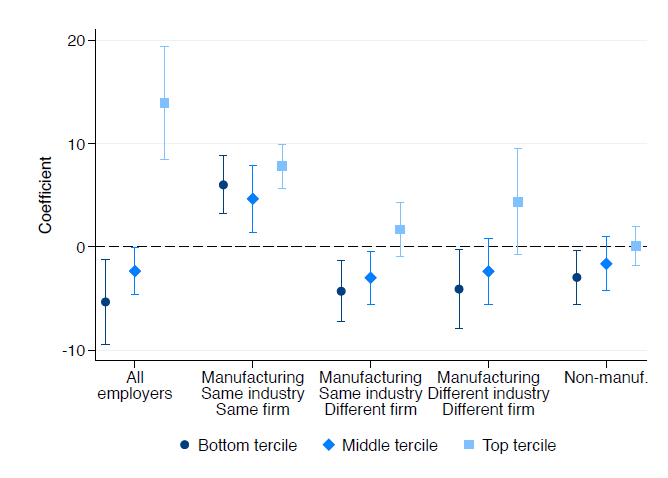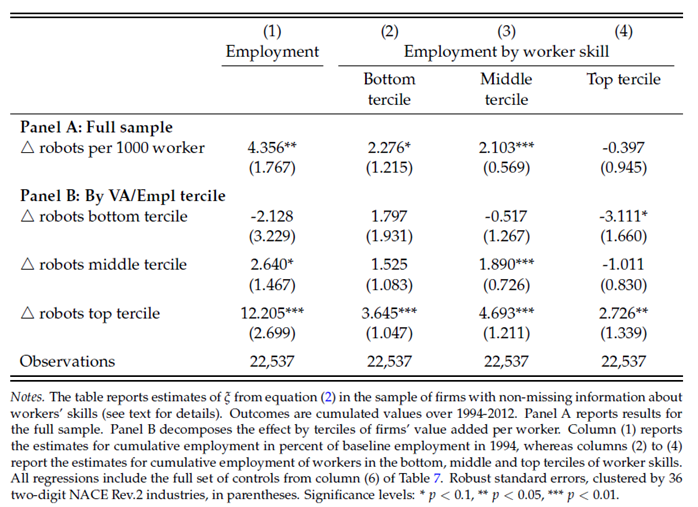The impact of automation on the labor market is one of the more widely discussed topics in the academic and policy debate. The fear is that automation can have disruptive consequences on the organization of labor, leading to a surge in unemployment of workers performing tasks that could be replaced by robots. Theoretical work on this subject highlights that there are two main economic effects of automation on the labor market: a displacement effect and a productivity effect. The former has a negative effect on employment as workers replaced by machines are displaced to other firms or to unemployment. The latter has a positive effect as firms become more productive and expand output and, therefore, employment. Which effect prevails is ultimately an empirical question.
In this paper, I contribute to the large and growing strand of the literature that attempts at giving answers to this question, by showing the worker-, firm- and sector-level adjustment of labor markets to robots. I focus on industrial robots, defined as “an automatically controlled, reprogrammable, multipurpose manipulator” (International Federation of Robotics, 2020), which are mainly deployed in the manufacturing sector. The surge of industrial robots in production processes is evident in all economies, as the number of operational robots increased by a factor of 4.9 in the world as a whole. I focus on Italy as a case study. Italy is an interesting country to analyze the impact of automation for two main reasons. First, it is the second largest robot market in Europe and the sixth worldwide. Second, Italy has a relatively rigid labor market and high employment protection legislation. The automation effects may be considerably different in countries with different labor market institutions.
I explore the impact of automation on the labor market along three lines. First, I investigate the worker-level adjustment to robots. Specifically, using detailed administrative linked employer-employee data, I compare the earnings, employment and wage trajectories of workers with similar observable characteristics that are initially employed in sectors with different automation exposure over the period 1994-2018. I deal with endogeneity in the relationship between labor market outcomes and automation by exploiting a standard instrumental variable strategy. I use the surge in robot exposure across sectors in other countries as an instrument for the national surge in robots. This analysis reveals that, as in Germany but differently from the United States, the impact of automation on employment is positive, with more exposed workers increasing their labor supply and experiencing lower rates of job churning, while I find no significant effects on earnings or wages. These effects, however, are highly heterogeneous and configure the presence of “winners” and “losers” from automation. Specifically, incumbent workers experience increased employment and earnings levels, whereas workers displaced to other firms – in manufacturing or outside of it – experience worse labor market outcomes. Figure 1 shows the change in labor market earnings between 1994 and 2018 for workers initially employed in sectors with different exposure to automation adoption. In sectors more exposed to automation, more skilled workers received higher wages, irrespective of whether they are employed in the same firm throughout the whole period 1994-2018 or if they are displaced to other firms. Low- and medium-skilled workers experience, instead, earnings penalties when displaced to other firms.
Worker and firm types matter for the magnitude of the adjustment: blue-collar and low-skill workers experience significant penalties, as well as workers initially employed in less productive firms, that is, firms in the bottom tercile of the value added per worker distribution. These results are confirmed if, instead of looking at employment as the main outcome, I use the number of days spent in unemployment or short-time work, for which I find results of opposite sign.
Second, I investigate the firm-level adjustment to robots, by using a subsample of my data with balance-sheet information over the period 1994-2012. Using a similar strategy to that adopted for the worker-level analysis, I find that firms in sectors with higher automation exposure expand employment and labor costs and witness significant increases in value added and sales. I then investigate how firms change their labor demand and I find that firms in sectors with higher automation exposure with low productivity levels decrease employment of high-skilled workers who move to more productive firms, contributing to higher assortative matching in the labor market (see Table 1). At the same time, more productive firms also increase employment of low- and middle-skilled workers, highlighting how the productivity effect of automation benefits all workers, but only in a limited subsample of firms with high productivity levels, contributing to reducing assortativeness in the labor market. The overall effect on labor market sorting is, therefore, ambiguous.
Finally, to further inspect the relationship between robots and sorting, I investigate how automation changes the allocation of workers across firms by adopting an event study strategy around automation spikes, that is, around events in which the number of industrial robots increases in a sector by a high margin relative to other sectors. I investigate how such “automation shocks” translate into labor market outcomes and specifically in how matching and sorting changes within each sector. I measure sorting as the correlation between worker skill-level and measures of firm types, such as, log value added per worker and log sales per worker. Overall, I find that there is a short-run negative and significant effect of automation on labor market sorting and a medium-run insignificant result (see Figure 2). This implies that, at least under this point of view, automation does not contribute to between firm earnings inequality, determined by high-wage workers being employed by more productive firms, but it contributes to between firm inequality as there is an increasing dichotomy between low-productive and high-productive firms and to between workers inequality in light of the differential effects for different worker types.
I presented the paper at seminars and workshop, e.g. the Annual Conference of the Italian Association of Labor Economists and the PhD workshop at Collegio Carlo Alberto (Turin), where my poster won the Riccardo Revelli Prize for the best poster.




